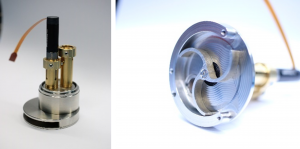
Two Color Cross Correlation Dynamic Light Scattering (CC-DLS)
DLS is a standard technique for small particle (1 nm-few μm) analysis and is based on optical measurement of particle diffusion: small particles move faster; large particles move slower. From temporal fluctuations of scattering intensities, particle diffusion coefficients can be calculated which are directly related to the hydrodynamic radius. The data analysis is based either on a Fourier transformation of the signal fluctuations to calculate the contained frequency components. High frequencies correspond to small particles, low frequencies correspond to larger particles. Alternatively, a correlation analysis of the scatter intensity as a function of time is done which results in a correlation time that is also correlated with particle size: shorter correlation times point to small particles, larger correlation times indicate larger particles. Commercially available fibre-optical backscatter immersion probes for DLS can measure relatively high concentration samples without dilution, because the optical penetration depth of the laser light can be restricted to a few μm. The biggest drawback with standard DLS for inline use is that it cannot be used in actively stirred or agitated solutions. The diffusional movement will be superimposed with liquid movements from the stirring process which will lead to errors in the particle size calculation.
Probe Head for Inline Measurements
By developing a novel probe-head that can be attached to a fibre-optical DLS-probe, the DLS-technique will be rendered inline-capable. With this we open up a new field of applications for DLS and go well beyond the state of the art. The probe-head separates a small volume of sample from the surrounding liquid and enables undisturbed DLS-measurements. With a rotating impeller the sample volume is exchanged and the next sample is transferred to the measurement chamber. Because the probe head is immersed in the sample, the sample does not have to be pumped to an external measurement device, and no thermal change is induced.

Cross Correlation DLS Technique for higher Concentrations
In order to enlarge the concentration range of the device, the standard DLS technique will be replaced with a two-color cross correlation setup. A system consisting of two DLS experiments performed at the same position inside the sample with two detectors, whose signals are cross-correlated, is very effective at suppressing multiply scattered photons. By using two slightly different Laser wavelengths and corresponding dielectric-coated bandpass filters in front of the two detectors, a cross-talk between the two experiments is suppressed.
With this strategy, the transmission range of measurable samples can typically be extended by one to two orders of magnitude. A miniaturized optical setup that can be integrated into the inline probe head will be developed in the PAT4Nano project. An alignment-free ultra-precise SLE-fabricated (selective laser etching) quartz-block will be used for positioning fibre optics for two excitation and two detection channels. SLE is a laser-based glass (or quartz, or sapphire) substrate structuring technology developed by Fraunhofer Institute for Laser Technology (ILT, Aachen).

The structuring is done with a femtosecond-Laser that changes the properties of quartz in the focus region and makes the material prone to etching (Selective Laser Etching).
Right picture: Cross-Correlation DLS probe containing two excitation and two detection channels focusing on the same spot with a precision of better than 10 µm.

